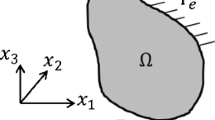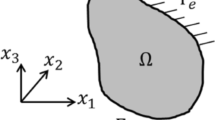Abstract
A general procedure to perform the sensitivity analysis for the shape optimal design of elastic structures is proposed. The method is based on the implicit differentiation of the discretized equilibrium equations used in the finite element method (FEM). The so-called semianalytical approach is followed, that is, finite differences are used to differentiate the finite element matrices. The technique takes advantage of the geometric modeling concepts typical of the computer-aided design (CAD) technology used in the creation of a compact design model. This procedure is largely independent of the types of finite elements used in the analysis and has been implemented in ah-version andp-version finite element program. Very accurate and stable shape sensitivity derivatives were obtained from both programs over a wide range of finite difference step sizes. It is shown that the method is computationally efficient, general, and relatively easy to implement. Some classical shape optimal design problems have been solved using the CONLIN optimizer supplied with these gradients.
Similar content being viewed by others
References
Bennett, J.; Botkin, M. (Eds.) (1986) The Optimum Shape: Automated Structural Design. New York: Plenum
Braibant, V.; Fleury, C. (1984) Shape optimal design using B-splines. Comput. Meth. Appl. Mech. Eng. 44, 247–267
Braibant, V.; Fleury, C. (1986) Shape optimal design—A C.A.D. oriented formulation. Engineering with Computers. 1, 193–204
Izadpanah, K. (1985) Computation of stress components in thep-version of the finite element method. DSc. dissertation, Washington University, St. Louis, MO
Izadpanah, K. (1986) Evaluation of thep-version of the finite element method. MSC/NASTRAN Users Conference, March
Mortenson, M.E. (1985) Geometric Modeling. New York: Wiley
Bohm, W.; Farin G.; Kahmann, J. (1984) A survey of curve and surface methods in CAGD. Comput Aided Geom. Des. 1, 1–60
Dhatt, G.; Touzot, G. (1984) The Finite Element Method Displayed. New York: Wiley
Fleury, C.; Liefooghe, D. (1986) Shape optimal design on an engineering workstation. Paper presented at the MSC/NASTRAN Users Conference, Universal City, CA March 20–21
Liefooghe, D. (1986) An interactive graphics capability for shape optimal design, Master of Science Thesis, University of California at Los Angeles.
Shyy, Y.K.; Fleury, C.; Izadpanah, K. (1987) Shape optimal design using high order elements. Paper presented at the 1987 MSC World Users Conference, Universal City, CA March 11–13
Fleury C. (1986) Shape optimal design by the convex linearization method. In: The Optimum Shape: Automated Structural Design (Eds. J. Bennett; M. Botkins). New York: Plenum
Fleury, C.; Braibant, V. (1986) Structural optimization—A new dual method using mixed variables. Int. Numer. Meth. Eng. 23, 409–429
Author information
Authors and Affiliations
Rights and permissions
About this article
Cite this article
Liefooghe, D., Shyy, Y.K. & Fleury, C. Shape sensitivity analysis using low- and high-order finite elements. Engineering with Computers 4, 213–228 (1988). https://doi.org/10.1007/BF01213983
Issue Date:
DOI: https://doi.org/10.1007/BF01213983




